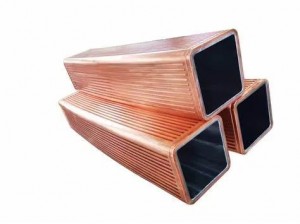Mainstream Coating Materials for Copper Mould Tubes: Core Advantages & Applications

In steel continuous casting, copper mould tubes endure high temperatures, wear, and corrosion—functional coatings are critical for performance. Mainstream options include metallic chromium, nickel-based alloys, and composite coatings. This article highlights their core advantages, applications, and key parameter comparisons.
1. Metallic Chromium Coatings: Mature Traditional Protection
Widely used in small/medium enterprises for plain carbon/low-alloy steel billet/bloom casting, their key strengths:
- Hard & Wear-Resistant: Electroplated chromium has HV 800-1000, extending tube life from 300-500 to 1000-1500 heats (units for measuring casting cycles).
- Corrosion-Stable: Dense Cr₂O₃ film isolates molten steel/slag, preventing segregation and tube corrosion.
- Cost-Effective: Controllable thickness (0.15-0.3 mm, <5% uniformity deviation), 2-4 hours per tube, low equipment costs.
Limitations: Low thermal conductivity (70 W/(m·K)) and environmental concerns—ideal for low-cost, low-speed casting (<2.5 m/min).
2. Nickel-Based Alloy Coatings: Optimized for High-Speed Casting
Addressing chromium’s thermal limitations, Ni-Co/Ni-Fe alloys are core for large enterprises’ high-speed casting:
- Superior Thermal Conductivity: Ni-Co (10%-20% Co): 150-180 W/(m·K); Ni-Fe (5%-15% Fe): 180-200 W/(m·K)—meets 3-4.5 m/min speed needs.
- Versatile: Suits plain carbon, low-alloy, and pipeline steel; stable oxide films resist Cr/Mo corrosion.
- Anti-Thermal Fatigue: <60% crack rate vs. chromium (200-800℃ cycles), 1000-1800 heats (units for measuring casting cycles) life; cyanide-free plating cuts wastewater costs by 40%.
Ni-Co (HV 500-700) fits high-wear slabs; Ni-Fe (HV 450-600, 15%-20% lower cost) suits blooms.
3. Composite Coatings: High-End Protection for Special Steel
For stainless/high-alloy steel (heat-resistant, bearing steel) casting (high-temp corrosion, billet adhesion), "metal matrix + reinforcing phase" coatings excel:
- High-Temp Corrosion Resistance: Cermet coatings (Ni/Cr + Al₂O₃/TiN) form stable films above 1000℃, 3-5x better corrosion resistance than chromium.
- Anti-Adhesion & Wear: Nano-coatings (e.g., nano-Cr-Al-N via physical vapor deposition (PVD)) have Ra <0.2 μm, friction coefficient 0.15-0.25—reduces billet adhesion.
- Durable: 1500-2500 heats (units for measuring casting cycles) life; nano-coatings (porosity <1%) are 50% more durable than traditional options.
Limitations: High equipment costs (high-velocity oxygen fuel (HVOF) thermal spraying equipment: 5-8 million RMB ≈ 0.7-1.1 million USD; PVD equipment: 10-15 million RMB ≈ 1.4-2.1 million USD) and low efficiency (4-12 hours/tube)—for special steel only.
Core Parameter Comparison
- Strengths: Chromium (HV 800-1000, low cost); Ni-Co (150-180 W/(m·K), anti-fatigue); Ni-Fe (180-200 W/(m·K), low cost); Cermet (HV 1200-2200, 1000℃+ resistance); Nano-coatings (Ra <0.2 μm, anti-adhesion).
- Steel Types: Chromium/nickel-based (plain carbon/low-alloy); nickel-based (pipeline); composites (stainless/high-alloy).
- Casting Speed: Chromium (<2.5 m/min); Ni-Co (3-4.5 m/min slabs); Ni-Fe (2.5-3.5 m/min blooms); composites (<3 m/min special steel).
- Life & Cost: Chromium (1000-1500 heats, low); nickel-based (1000-1800 heats, medium); composites (1500-2500 heats, high).
Selection & Trends
- Selection: Small/medium low-speed lines (chromium); large high-speed lines (nickel-based); special steel (composites).
- Trends: Greenization (chromium-free); multi-functionality (wear/corrosion/thermal control); intelligence (digital twin optimization).
Post time: Oct-24-2025